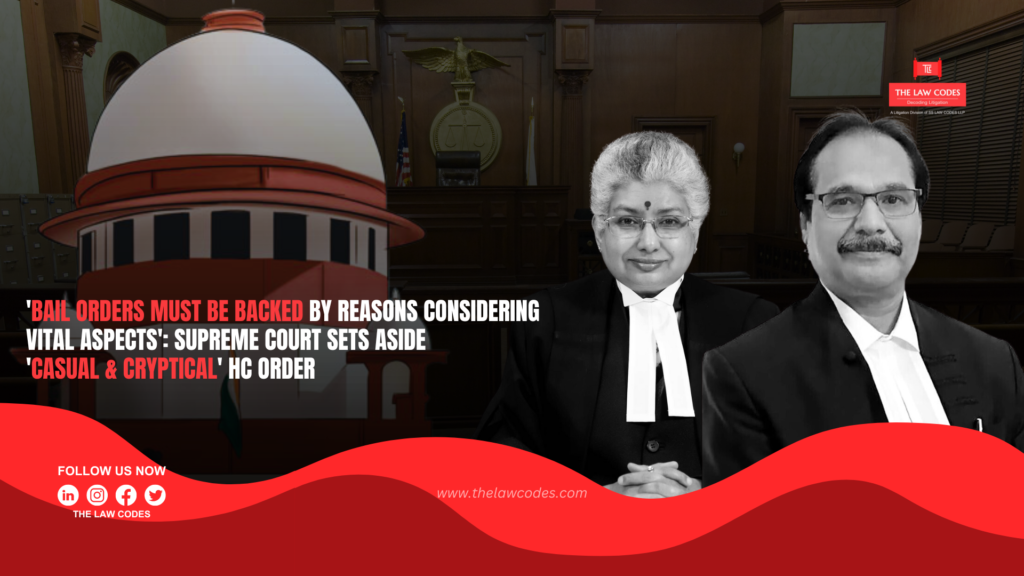
‘Bail Orders Must Be Backed By Reasons Considering Vital Aspects’: Supreme Court Sets Aside ‘Casual & Cryptical’ HC Order
The hon’ble Supreme Court ruled that crucial aspects of the case must be considered when determining a bond. The courts must also consider the character of the crime, the criminal history of the accused, and the nature of the punishment involved. While exercising discretion in granting parole, the Court pushed for orders to be supported by reasoning.
The Supreme Court bench of Justices B.V. Nagrathna and Prashant Mishra was hearing an appeal against the Rajasthan High Court, which had granted parole to the respondents in an honour killing case.
Setting aside the “cryptic” and “casual” parole orders issued by the High Court, the Supreme Court observed:
“While considering an application for grant of bail, a prima-facie conclusion must be supported by asons and must be arrived at after having regard to the vital facts of the case brought on record. ue consideration must be given to facts suggestive of the nature of crime, the criminal anteceden f the accused, if any, and the nature of punishment that would follow a conviction vis à vis the ffence/s alleged against an accused.“
CONTENTIONS
The appellant argued that the impugned judgement was rendered without considering the respondents’ active participation and the grievous nature of the crime, for which they could face life in prison or the death penalty for the murder of the deceased.
Despite overwhelming evidence indicating the respondents’ culpability, he argued that bail was granted without any justification and in a perverse manner. The state’s attorney also argued that eyewitnesses and CCTV footage showed the respondents fleeing the crime scene. On the other hand, the party respondents argued that even if the alleged crimes are severe, they are entitled to bail if they were not implicated in the crime. They argued that there was no evidence to establish that they struck and shot the deceased. They argued that they were already in judicial custody when the female witness turned hostile. Consequently, it is unthinkable for them to have influenced the witness.
ANALYSIS OF THE SUPREME COURT
“The Supreme Court perused the bail orders passed by the H.C., which noted, “Having regard to the totality of the facts and circumstances of the case, without expressing any opinion on the merits of the case, I deem it just and proper to grant bill to the accused petitioners under Section 439 Cr. P.C.” The Court expressed displeasure that the H.C. granted parole without any justification and in a very casual manner. It relied solely on the antagonistic woman’s testimony, which is not a consideration for granting bail. It held that H.C. did not consider a single material aspect of the case.
“High Court while passing the impugned orders has not taken into account even a single material aspect of the case. Instead, the High Court referred only to the testimony of one hostile witness in the trial and on the basis thereof, exercised its discretion to grant bail in an erroneous manner. The High Court has lost sight of the aforesaid vital aspects of the case and granted bail to the respondents by passing very cryptic and casual orders, de hors cogent reasoning,” observed Justice Nagarathna in the judgment.
The Court cited a recent decision in Manoj Kumar Khokhar v. State of Rajasthan 2022 LiveLaw (SC) 55, in which it was determined that “an order granting bail to an accused, if passed in a casual and cryptic manner, de hors reasoning that would validate the grant of bail, is subject to being set aside by this Court.”
The Court reiterated the factors to be considered for bail, including the gravity of the offence, the likelihood of the defendant evading justice, the impact of the defendant’s release on prosecution witnesses, and the possibility of the defendant tampering with evidence. It was observed, “While the liberty of an individual is important, the courts cannot lose sight of the serious nature of the accusations against an accused“.
Upon review of the indictment and evidence submitted, the Court noted how the deceased was located, what reconnaissance the defendants conducted before the incident, and how they participated. Based on this, the Supreme Court was persuaded that, at least prima facie, there is evidence pointing to the respondent’s culpability. Since one of the prosecution’s witnesses had turned hostile, the Court opined that there was a chance that respondents could influence witnesses.
Therefore, the Supreme Court vacated the verdict and ordered the defendants to surrender.
